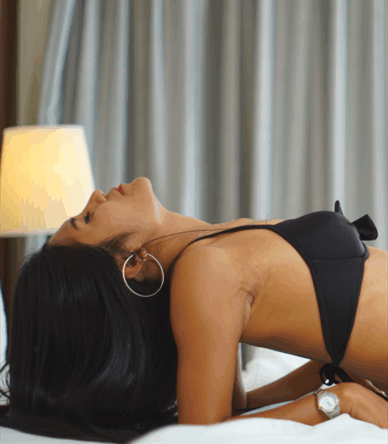What is back stepping?
– Definition: Back stepping is a massage technique that involves applying pressure to the back with the feet (or sometimes the knees) to relax muscles, relieve fatigue or improve blood circulation. The person applying the force usually stands or squats and gently steps on or presses the recipient's back with the sole of the foot.
– Cultural Background:
– China: Back massage is very common in Chinese families or traditional massage, and is often performed between relatives (such as parents massaging their children’s backs) or in professional massage places.
– Other regions: In Southeast Asia (such as Thailand) and Japan, back-stepping is also a traditional therapy that combines acupressure and body balance concepts.
– Modern setting: Back stepping may occur at home, in a physical therapy center, at a spa, or as an intimate interaction between couples.
– Form:
– Non-professional: back massage between relatives, friends or partners for the purpose of relaxation.
– Professional: performed by a masseur or physiotherapist, combined with other massage techniques.
– Entertainment or fun: In some intimate or adult situations, back-trampling may be used as foreplay or relaxation, but this is less common.
—
The benefits of back pedaling
Back massage as a form of physical massage has the following potential benefits:
1. Relieve muscle tension:
– The back (especially the shoulder blades and waist) is often stiff due to long-term sitting, fatigue or stress. Stepping on the back can relax the muscle fibers.
– Ideal for office workers, athletes or people who maintain a single posture for long periods of time.
2. Improves blood circulation:
– Foot pressure stimulates blood flow to the back, relieves fatigue, and improves local oxygen supply.
3. Reduce stress:
– Massage stimulates the body to release endorphins, which leads to a feeling of relaxation and pleasure.
– In intimate relationships, stepping strengthens emotional connection.
4. Improve Posture:
– Relaxing your back muscles may relieve minor aches and pains caused by poor posture, such as rounded shoulders or lower back pain.
5. Acupoint stimulation:
– In traditional Chinese medicine theory, there are many acupuncture points on the back (such as Dazhui and Mingmen). Stepping on the back may stimulate these acupuncture points and adjust the body’s balance (professional guidance is required).
—
Back-stepping techniques
To ensure that back pedaling is safe, comfortable, and effective, here are some practical tips:
1. Preparation:
– Environment: Choose a flat, soft surface (such as carpet, yoga mat, or bed) and avoid operating directly on hard floors.
– Recipient position: The recipient lies flat on his back (prone), with his head supported by a towel or pillow, keeping his neck relaxed.
– Hygiene of the force applicator: Make sure the feet are clean, preferably washed and dried, and avoid wounds or infections on the feet.
– Communication: Ask the recipient about their comfort level and pain areas in advance and set a strength range.
2. Operation steps:
– Warm up: The person applying the force first gently rubs the back with their hands to relax the muscles and increase blood flow.
– Start stepping on your back:
– The person applying force stands or half squats, and gently presses the back with the sole of the foot (forefoot or heel), moving gradually from the shoulder to the waist.
– Key areas: both sides of the shoulder blades, both sides of the spine (avoid direct pressure on the spine), and the waist.
– Strength: From light to heavy, observe the recipient’s reaction and maintain even pressure.
– Rhythm: Pedal slowly and rhythmically, staying at each position for 3-5 seconds, and avoid rapid or sudden force.
– Supplemental support: The person applying force can hold on to a wall, a chair or another person to ensure balance and avoid falling.
– Ending: Use your hands to gently massage the stepped area to promote blood circulation and relax muscles.
3. Recommended posture:
– Standing back pressing: The person applying force stands and applies pressure with one or both feet alternately, which is suitable for stronger force.
– Half-squat back-stepping: The person applying force half-squats and presses lightly with the soles of the feet or knees, which is suitable for fine control.
– Seated assistance: The force applicator sits on the receiver’s hips and presses the upper back with his feet or hands, which is suitable for family scenarios.
4. Time and frequency:
– It is recommended to do the back exercise for 10-20 minutes each time to avoid muscle fatigue caused by prolonged exercise.
– 1-2 times a week is appropriate, depending on personal needs and physical condition.
—
Risks and precautions
Although back stepping is a common way to relax, it can be risky if done incorrectly. Here are some things to note:
1. Physical risks:
– Spinal injuries: Stepping directly on the spine or applying excessive force may cause disc damage or nerve compression.
– Muscle or skin injuries: Excessive force may cause bruises, muscle strains, or skin abrasions.
– Special populations:
– Pregnant women: Avoid stepping on the back, especially the waist and abdomen, as this may affect the safety of the fetus.
– Osteoporosis patients: The bones are fragile and stepping on the back may cause fractures.
– Patients with cardiovascular disease: Massage may affect blood pressure, so be careful.
– Recent surgery or trauma: Avoid applying pressure to the injured area.
2. Hygiene risks:
– Unclean feet or environment may lead to skin infections (such as athlete’s foot).
– Recommendation: The person applying the force should wash their feet, using a clean towel or mat.
3. Emotional and comfort risks:
– In an intimate relationship, backstepping should be done in a way that is comfortable for both parties and avoids one party feeling uncomfortable or forced.
– Non-professional operation may result in poor results or discomfort due to improper techniques.
4. Precautionary measures:
– Avoid direct pressure on the spine: focus on the muscles on both sides of the spine (such as the erector spinae).
– Control the force: Be extra careful when the person applying force is overweight and use your hands to support your weight.
– Communicate at any time: The recipient should report any pain or discomfort at any time, and the person applying the force should make adjustments immediately.
– Professional guidance: If you are unsure about the technique, it is recommended to consult a masseur or physiotherapist.
—
Cultural and social context
– Chinese Tradition: Patting on the back is often seen as an intimate way of caring in Chinese families, such as children patting their parents’ backs, or couples massaging each other.
– East Asian massage culture: In Thailand, Vietnam and other places, back stepping is combined with traditional medicine (such as Chinese acupoint theory or Thai massage) to emphasize body balance.
– Modern evolution:
– In a SPA or physical therapy center, back stepping may appear in the form of "foot massage" or "back massage", which is more professional.










